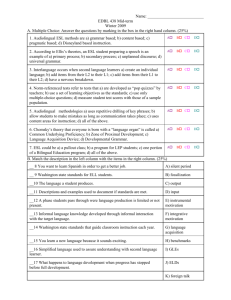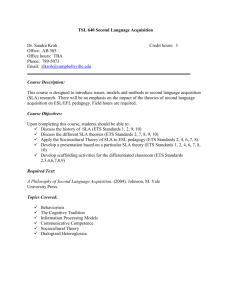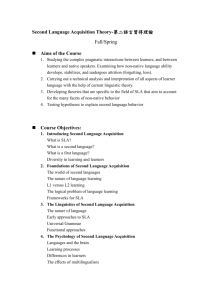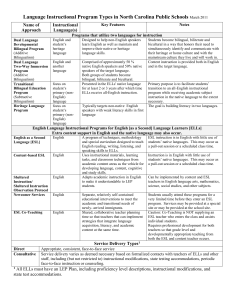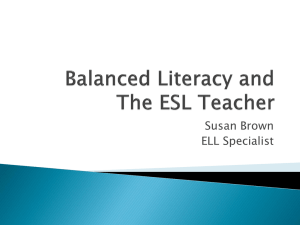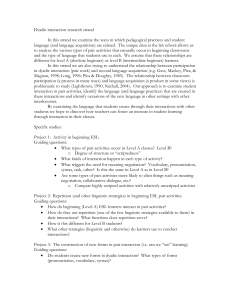Second Language Acquisition and Culture - MyCC
advertisement
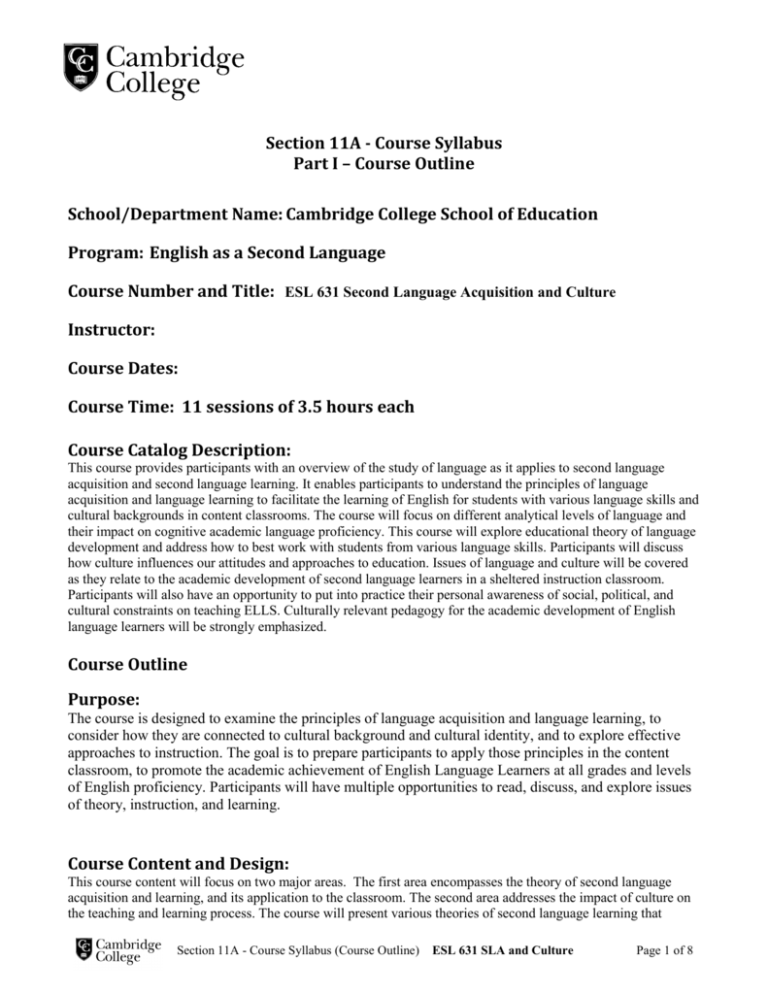
Section 11A - Course Syllabus Part I – Course Outline School/Department Name: Cambridge College School of Education Program: English as a Second Language Course Number and Title: ESL 631 Second Language Acquisition and Culture Instructor: Course Dates: Course Time: 11 sessions of 3.5 hours each Course Catalog Description: This course provides participants with an overview of the study of language as it applies to second language acquisition and second language learning. It enables participants to understand the principles of language acquisition and language learning to facilitate the learning of English for students with various language skills and cultural backgrounds in content classrooms. The course will focus on different analytical levels of language and their impact on cognitive academic language proficiency. This course will explore educational theory of language development and address how to best work with students from various language skills. Participants will discuss how culture influences our attitudes and approaches to education. Issues of language and culture will be covered as they relate to the academic development of second language learners in a sheltered instruction classroom. Participants will also have an opportunity to put into practice their personal awareness of social, political, and cultural constraints on teaching ELLS. Culturally relevant pedagogy for the academic development of English language learners will be strongly emphasized. Course Outline Purpose: The course is designed to examine the principles of language acquisition and language learning, to consider how they are connected to cultural background and cultural identity, and to explore effective approaches to instruction. The goal is to prepare participants to apply those principles in the content classroom, to promote the academic achievement of English Language Learners at all grades and levels of English proficiency. Participants will have multiple opportunities to read, discuss, and explore issues of theory, instruction, and learning. Course Content and Design: This course content will focus on two major areas. The first area encompasses the theory of second language acquisition and learning, and its application to the classroom. The second area addresses the impact of culture on the teaching and learning process. The course will present various theories of second language learning that Section 11A - Course Syllabus (Course Outline) ESL 631 SLA and Culture Page 1 of 8 support students’ academic development in the Sheltered English Instruction (SEI) classroom. Participants will examine how diverse societal and environmental factors influence second language acquisition and language learning. Participants will have an opportunity to put into practice their personal awareness of social, political and cultural constraints on teaching ELLs. This design will prepare students to understand and apply key factors in a Participants will have multiple opportunities to experience the sheltered instruction strategies through the use of interactive lectures, small and large group instruction, lesson plan presentations, reflections, analysis of videos and podcasts, and cooperative learning activities. Course assignments are designed to enable students to target the grade level (PreK-6, 5-12, or Adult) at which they teach, or plan to teach. Course Outcomes Knowledge Outcomes Discuss the role of students’ home culture, personal identity, and adaptation to the U.S. Recognize language varieties, structures and use, and their significance to language development. Identify classroom culture and practices that foster language development for ELLs. Compare the historical theories of language development with SEI instruction today. Describe psychological and sociocultural factors that influence second language acquisition, and their implications for SEI instruction. Differentiate between social and academic language. Explain the purpose of the WIDA English Language Development Standards OR Massachusetts Curriculum Framework for ELA and Literacy Incorporating the Common Core State Standards and its implications for instruction. Skill Outcomes Analyze and discuss a language sample from an ELL. Analyze their own learning of a second language, and discuss its implications for instruction. Examine their own classroom as a site for second language acquisition, determine potential problem areas, and identify appropriate adjustments. Interpret ELL and teacher behavior from a cultural perspective. Reflect critically on key points presented in assigned readings and videos. Participate in varied grouping formats, and discuss appropriate uses with ELLs at different English proficiency levels. Use the Massachusetts Curriculum Framework for ELS and Literacy and the WIDA Can Do Descriptors to write lesson plans with appropriate content and language objectives. Required Texts: Diaz-Rico, Lynne T. & Weed, K. (2010). 4th Edition. The Cross-Cultural, Language, and Academic Development Handbook: A Complete K-12 Reference guide. Boston MA: Allyn and Bacon. ISBN 9780-13-715409-8. WIDA (World-Class Instructional Design and Assessment) English Language Development Standards, 2012, and ‘Can Do’ Descriptors P-12; available at www.wida.us/standards/CAN_DOs/ Massachusetts Curriculum Framework for ELA and Literacy Incorporating the Common Core State Standards available at www.doe.mass.edu Section 11A - Course Syllabus (Course Outline) ESL 631 SLA and Culture Page 2 of 8 Highly Recommended: Brown, D. (2007). Principles of Language Learning and Teaching, 5th Edition. White Plains NY: Longman Publishing. ISBN 0-13-199128-0. Recommended Texts: Freeman, D.E. & Freeman, Y.S. (2004). Essential Linguistics – What You Need to Know to Teach Reading, ESL, Spelling, Phonics, Grammar. Portsmouth NH: Heinemann. Andrews, Larry (2001). Linguistics for L2 Teachers. Mahweh NJ: Lawrence Erlbaum Associates. Urdaneta Hernandez, L.A. (2002). Linguistic and Cultural Dimensions of Second Language Acquisition: A Venezuelan Case Study. USA: Xlibris Corporation. Krashen, S.D. (2003). Explorations in Language Acquisition and Use. Portsmouth NH: Heinemann. Krashen, S.D. & Terrell, Tracy D.(2000). The Natural Approach: Language Acquisition in the Classroom. Harlow, England: Longman Publishing. Course Requirements: For each class session, you will need to read thoroughly the assigned readings to be prepared to actively contribute to class discussions and interactions, including individual tasks and small group activities. Participation will be part of your final grade. Your course participation includes: preparation of assigned readings, completion of reading-related activities, completion of course assignments, and the presentation of a final product. Assignments are to be submitted on time and professionally presented. Attendance (Mandatory) and Participation - 10% Class attendance and participation are important. Participants are expected to prepare in advance for class discussion of assigned readings. Each day, there will be a number of opportunities to work actively in groups and it is important that everyone take an active role in the group work. Representational Study of a Language and Culture – 10% Participants will select a language and culture to study. A project-based action research project will be done on that language and culture and shared with the class. The purpose of this project is to better understand a culture of a current or future student group. Choices for what you might do will be discussed in class. Language Sample Analysis – 10% Participants will be given a case study of a second language learner. They will analyze the learner’s data using linguistic and sociolinguistic concepts from the readings and class discussion. Based on their analysis, they will consider implications for teaching. Reading Reflection Summaries – 15% Reading reflection summaries are one-page, single-spaced written responses to readings from textbooks, packet of Internet articles. These summaries are intended to help focus your reaction to the course readings and to facilitate our in-class discussion of them. A reading reflection summary consists of two Section 11A - Course Syllabus (Course Outline) ESL 631 SLA and Culture Page 3 of 8 parts: Part 1 summarizes, in your own words, the content of the article. Part 2 provides a reflective response, i.e., your personal comments, questions, counter-arguments to the specific ideas and details in the reading. You will complete 6 reading reflections on second language acquisition and learning and culture. Second Language Learner Interview – 10% Instructions will be given in class. Final Paper – 30% Instructions will be handed out the second week in class. Journal – 15% There will be many opportunities in class for students to respond to a topic being addressed. The journals will be the place for you to keep your thoughts. The grading criteria for the journal writing will be based on how your reflection connects to the topic. The journal will be given to the instructor on the last day of class. Topics for Discussion Culture and Cultural Diversity What is culture? What are the principal characteristics of culture? How does our own cultural background affect how we approach second language learning and teaching? As an educator how, when and why would you integrate language and culture in the content area classroom? Language Acquisition and Language Learning What are the principles of language, and how does the primary language influence English acquisition/ What role does the teacher have in creating a positive classroom climate to facilitate ELLs’ l anguage development? How can we empower ELLs to optimize their learning experience n the SEI classroom? Pre-Practicum: Early field based experiences in a variety of diverse settings, integrated into courses or seminars that address either the Professional Standards for Teachers as set forth in 603 CMR 7.08 or the Professional Standards for Administrators as set forth in 603 CMR 7.00. For candidates serving an apprenticeship or employed as educator of record, these experiences may occur simultaneously with the practicum or the practicum equivalent Pre-Practicum Assignment Classroom observations and assignments will total 15 hours. 1. Observe in an ESL or SEI classroom, or a general education classroom that includes ELL students. If possible, before the lesson begins, ask the teacher about the cultural/linguistic composition of the class. During your observation, take note of factors such as: a. b. c. d. What is the general climate/mood of the classroom? Does the teacher call on students, or wait for volunteers? Are the ELLs able to participate? Note the body language and behavior of teacher and students, and compare this with what you learned in your language and culture study. Do you see interactions that support the students’ cultural background knowledge? e. How does the teacher respond when a student gives an answer that is correct? Incomplete or incorrect? Section 11A - Course Syllabus (Course Outline) ESL 631 SLA and Culture Page 4 of 8 2. Write a reflection that discusses a-e above. 3. Interview an ELL about family members, friends, favorite subjects, etc. Ask if s/he sometimes has trouble understanding what to do in school, and what s/he does when that happens? 4. Write a separate report about: (a) A description of the strategies and activities you observed that provided cultural support for ELLs. (b) Strengths and challenges of the lesson for ELLs. (c) How well the ELLs were able to participate in the lesson. (d) How the teacher checked for understanding throughout the lesson. (e) Your questions and suggestions for the lessons you observed. Strategies for Integrating English Language Learners in the Classroom English language learners will be integrated in the classroom using a variety of learning formats, including graphic presentation of information, oral discussion, hands-on activities, and small group projects. Strategies for Integrating Students with Disabilities in the Classroom Students with disabilities will be integrated in the classroom based on individual needs, in accordance with advice of the Disabilities Support Services office. Strategies for Integrating Instructional Technology Students will utilize a variety of instructional technology including laptop computers, PowerPoint projection slides, webinars and internet resources for teaching language and content (science, mathematics, and history), email, CDs/DVDs, and flash drives. Strategies for Integrating Diversity into the Curriculum Students will be encouraged to use their individual background experiences, and their reflections on course readings, as the basis for contributing to class discussions and for treating the contributions of others with respect. Class presentations and recommended readings will provide examples from varied countries, linguistic and cultural groups, and racial and ethnic groups in the U. S. Licensure Standards Assessed: This course specifically targets the following Professional Licensure Standards and ESL Subject Matter Knowledge requirements from the Massachusetts Department of Elementary and Secondary Education. Professional Licensure Standards: 7.08 Course: ESL 631 Second Language Acquisition and Culture Professional Description Evidence Covered in this Semester Standards Standard A Plans Curriculum and Instruction Standard B Delivers Effective Instruction Reading reflections and class discussions will discuss factors for planning. To integrate language and culture into the classroom Language and culture study, interview, and language analysis will discuss key issues to be part of instructional planning. Language sample analysis will consider appropriate linguistic and sociolinguistic factors in building vocabulary, and syntax. Language and culture study, language sample analysis, and student interview will show understanding of cultural influences on teaching and learning. Pre-practicum observation notes and report include Section 11A - Course Syllabus (Course Outline) ESL 631 SLA and Culture Page 5 of 8 Standard C Manages Classroom Climate and Operation Standard D Promotes Equity Standard E Meets Professional Responsibilities discussion of linguistic and cultural factors. Pre-practicum observation notes and report may discuss observation of teacher’s role in setting a positive classroom climate. Reading reflections and class discussions will demonstrate awareness of the teacher’s role in maintaining a setting of respect and civility. Readings and research in language acquisition and learning include discussion of implications for classroom practice. Collaboration with course colleagues to improve instruction, assessment, and student achievement. Critical reflection on students’ own teaching experience, through course assignments, discussions, and final paper. MA Subject Matter Standards Assessed 7.06: (9) Standard Assignment Evidence Covered in this Semester 7.06: (9)(a) 1.a. Language as a system: functions and registers of language. 7.06: (9)(a) 1.c. Language variation and change. ELL interview Language sample analysis Language-culture study ELL interview Language sample analysis Language-culture study 7.06: (9)(a) 2.a. Theory and research in second language acquisition. 7.06: (9)(a)4. Socio-cultural and socio-economic considerations in teaching ESL. Readings Final paper ELL interview Language sample analysis Language-culture study Reading reflections Class discussions The language-culture study, interview reflection, language analysis, and class discussions will show understanding of language as a system. The language and culture study will show awareness of relevant factors; the interview and language sample analysis will reinforce these factors. The reading reflections and final paper will demonstrate understanding of key theories. The language-culture study, interview reflection, language analysis, reading reflections, and class discussions will demonstrate understanding of socio-cultural and socio-economic considerations. Strategies for Assessing Student Performance and Awarding a Letter Grade: Rubric for Class Participation Does Not Meet Standard 1-3 Approaches Standard 4-6 Meets Standard 7-9 Exceeds Standard 10 1. Comments in class discussions show understanding of concepts presented in class and readings. 2. Participation in class activities shows collaboration and respect. 3. Application assignments, observations, and other contributions are focused, relevant, expressed clearly, and connected to instruction. 4. Observation reflections (if applicable) are thorough and connected to instruction. Section 11A - Course Syllabus (Course Outline) ESL 631 SLA and Culture Page 6 of 8 Rubric for Written Assignments Does Not Meet Standard 1-3 Approaches Standard 4-6 Meets Standard 7-9 Exceeds Standard 10 1. Format follows course guidelines. 2. Information is provided in a well organized manner. 3. Ideas are expressed clearly using correct mechanics of writing. 4. Lesson plans/research assignments include a required number of sources and appropriate citations. Grading Policy: 1. 10% 2. 10% 3. 10% 4. 15% 5. 10% 6. 30% 7. 15% Attendance (Mandatory) and Participation Representational Study of a Language and Culture Language Sample Analysis Reading Reflection Summaries Second Language Learner Interview Final Paper Journal Attendance Policy. Because class participation is integral to establishing our own community of learners, you are required to attend all classes and engage in class discussions to receive credit for the course. If lateness becomes a chronic problem, your grade for the class will be lowered. Punctuality is always professional. Class will begin promptly. Thank you for joining us in maximizing our time together by honoring this time frame. Assessment /Grading Policy: Full credit can only be received for assignments submitted on time. Absenteeism and chronic lateness will lead to a lower grade. Academic Integrity Students are expected to maintain integrity in all academic work. They will not attempt to get grades by any means other than honest academic effort. All work must be completed by individual students except for group projects. It is not permissible to hand in the same work for different courses. Plagiarism is the use of another’s work, thoughts, or language without giving credit. Cambridge College students will not summarize, copy, or use the work of another person or source without proper acknowledgement. Plagiarism is dishonest and a serious academic offense. Any breach of academic integrity is grounds for a grade of “No Credit” in academic courses and/or dismissal from the College. Disability Support In compliance with Cambridge College policies and the Americans with Disabilities Amendments Act, the Office of Academic & Disability Support Services arranges access to facilities and academic programs for students with physical, psychological, or learning disabilities of permanent or temporary duration. Accommodations are determined on an individual basis and include, but are not limited to, Section 11A - Course Syllabus (Course Outline) ESL 631 SLA and Culture Page 7 of 8 note takers, sign language interpreters, accessible texts, classroom modifications, and parking. Any student who feels s/he may be eligible for accommodations that provide equal access to educational programs at Cambridge College should contact the Coordinator of Academic and Disability Support Services at 617-873-0191 or disabilitysupport@cambridgecollege.edu for an appointment. Students with disabilities are responsible for identifying themselves, and for providing documentation from qualified and licensed medical or testing personnel. Any expense incurred in obtaining such documentation is the student's responsibility. This documentation must present a specific diagnosis of the disability, explain its limiting effects, and make recommendations for accommodations. It is important to provide this documentation as early as possible so that timely and appropriate arrangements can be made. New students must contact us at least three weeks prior to the beginning of the term, since many services must be arranged far in advance. Each term, faculty are notified of any students with disabilities in their courses and are told of the accommodations required. All students are expected to fulfill essential course requirements in order to receive a passing grade, with or without reasonable accommodations. Accommodations cannot be granted retroactively. Library Online Library Services: What are the Cambridge College library resources? For a description of all library services and resources, see “All About Library Services and Resources at Cambridge College” at http://www.cambridgecollege.edu/student/research.cfm For instructions for using library services, see www.cambridgecollege.edu/student/research.cfm Cambridge College Online Library (CCOL) provides an extensive collection of full-text articles from thousands of scholarly journals and full-text books, live reference librarian support 24 hours every day, and instruction and resources for doing research in all our subject areas. It’s free, it’s always available, and it is at www.cambridgecollege.edu/library/ For information about traditional library arrangements for your campus site, see http://www.cambridgecollege.edu/library/traditional.cfm To find an appropriate traditional library in your local area, see "Find a local Library, Anywhere" http://www.cambridgecollege.edu/student/research.cfm For instructions and resources for researching and writing your research papers, see www.cambridgecollege.edu/student/research.cfm If you need the current username/password to use the Cambridge College Online Library, please ask me in class or in a personal email, as I cannot post it in any manner. You can also get the username/password by following the instructions on the page http://www.cambridgecollege.edu/library/students.cfm Section 11A - Course Syllabus (Course Outline) ESL 631 SLA and Culture Page 8 of 8
